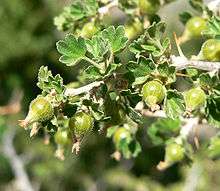Ribes velutinum
| Desert gooseberry | |
|---|---|
 | |
| Scientific classification | |
| Kingdom: | Plantae |
| (unranked): | Angiosperms |
| (unranked): | Eudicots |
| (unranked): | Core eudicots |
| Order: | Saxifragales |
| Family: | Grossulariaceae |
| Genus: | Ribes |
| Species: | R. velutinum |
| Binomial name | |
| Ribes velutinum Greene [1] | |
| Varieties | |
|
Ribes velutinum var. gooddingii (M.Peck) C.L.Hitchc. [2][3] | |
| Synonyms[4] | |
| |
Ribes velutinum is a species of currant known by the common name desert gooseberry. [5]
Distribution
It is endemic to the deserts and mountains of the Western United States. It is native to areas in Montana, Idaho, Washington, Oregon, Utah, Nevada, California, and Arizona),[6][7]
It grows in many types of habitat, including sagebrush scrub, pinyon-juniper woodland, and yellow pine forest. [5]
Description
Ribes velutinum is a spreading shrub with a thick, arching, multibranched stem growing up to 2 meters (80 inches) long. Nodes along the stems are armed with spines which may reach 2 centimeters (0.8 inch) in length. These are spines, not prickles, as they are derived from leaf material rather than from the plant epidermis (skin).
The thick, leathery leaves have generally rounded blades divided shallowly into three or five lobes and dotted with glandular hairs. The small blades are borne on petioles.
The inflorescence is a solitary flower or raceme of up to four flowers. Each small flower is a tube of white or yellowish sepals with smaller, similarly colored petals inside. The bloom period is April and May.
The fruit is an edible berry one half to one centimeter (0.2-0.4 inch) wide which ripens yellow, then reddish or purple.[8][9]
Varieties
- Ribes velutinum var. goodingii — Gooding's gooseberry, endemic to the Great Basin region in California, Nevada, Idaho, Washington, Oregon. [10]
See also
- Endemic flora of the United States
- Flora of the Great Basin
References
- ↑ Species was first described and published in the Bulletin of the California Academy of Sciences 1(3): 83. 1885. "Plant Name Details for Ribes velutinum". IPNI. Retrieved July 21, 2010.
- ↑ "Profile for Ribes velutinum variety goodingii (Gooding's gooseberry)". PLANTS Database. USDA, NRCS. Retrieved July 21, 2010.
- ↑ Ribes velutinum var. goodingii was published in Vascular Plants of the Pacific Northwest 3: 84. 1961. "Plant Name Details for Ribes velutinum var. goodingii". IPNI. Retrieved July 21, 2010.
- ↑ Tropicos, Ribes velutinum Greene
- 1 2 Calflora: Ribes velutinum
- ↑ "Profile for Ribes velutinum (desert gooseberry)". PLANTS Database. USDA, NRCS. Retrieved July 21, 2010.
- ↑ Biota of North America Program 2014 county distribution map
- ↑ Flora of North America, Ribes velutinum
- ↑ Greene, Edward Lee 1885. Bulletin of the California Academy of Sciences 1(3): 83–84
- ↑ USDA Plants Profile for Ribes velutinum var. gooddingii (Gooding's gooseberry)
External links
- Calflora Database: Ribes velutinum (Desert gooseberry)
- Jepson Manual eFlora (TJM2) treatment of Ribes velutinum
- USDA Plants Profile for Ribes velutinum (desert gooseberry)
- Missouri Botanical Garden: herbarium specimen (1905)
- UC Calphotos gallery: Ribes velutinum images
| Wikimedia Commons has media related to Ribes velutinum. |